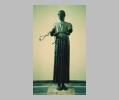
Delphi Charioteer, right hand and reins, frontal view

The Delphi Charioteer: view from the slight right

Delphi Charioteer, lower torso and legs, frontal view

Delphi Charioteer, back of torso, detail

Delphi Charioteer, lower torso and legs, three-quarter view from right

Delphi Charioteer, torso and head, back view
| Collection: | Delphi Archaeological Museum |
| Title: | Delphi Charioteer |
| Context: | From Delphi |
| Findspot: | Excavated at Delphi |
| Summary: | Charioteer standing in chariot with team of horses |
| Object Function: | Victory |
| Material: | Bronze |
| Sculpture Type: | Free-standing statue |
| Style: | Early Classical |
| Technique: | Hollow cast |
| Original or Copy: | Original |
| Date: | ca. 478 BC - ca. 474 BC |
| Dimensions: | H of charioteer: 1.80 m |
| Scale: | Life-size |
| Region: | Phocis |
| Period: | Early Classical |
Condition: Nearly complete
Condition Description:
Statue of the charioteer preserved in 3 fragments: torso with head (3520), lower torso from waist to feet (3485), right arm (3540). Only the left arm is missing. Other bronze fragments belonging to the group include fragments of the horses, harnesses, chariot and the inscribed stone base on which the group stood. In addition to the bronze, added materials for the eyes (inlay of glass and stone), headband (silver inlay) and mouth (copper-plate) are preserved.
Technique Description:
Cast by lost-wax process, probably a combination of the direct and indirect processes (
Inscription:
On the front face of a trapezoidal block of gray-beige limestone (said by Chamoux to be from the quarries of Parnassus), in two lines:
Sources Used: